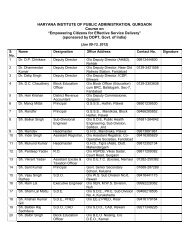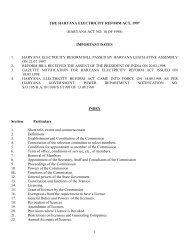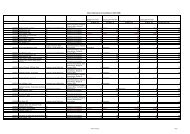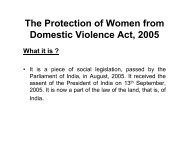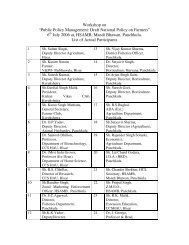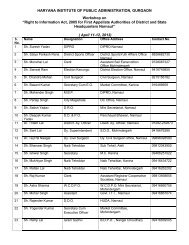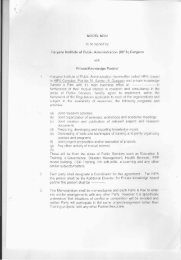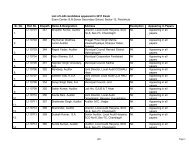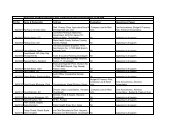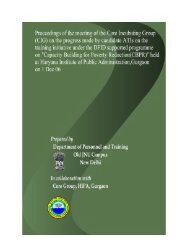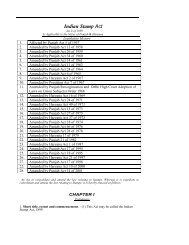Dr. G. Prasanna Kumar - HIPA
Dr. G. Prasanna Kumar - HIPA
Dr. G. Prasanna Kumar - HIPA
You also want an ePaper? Increase the reach of your titles
YUMPU automatically turns print PDFs into web optimized ePapers that Google loves.
Primary Sector and the 11 th Plan:<br />
The Haryana Context<br />
<strong>Dr</strong>. G. <strong>Prasanna</strong> <strong>Kumar</strong>,<br />
Director General, Haryana Institute of Public Administration<br />
Gurgaon<br />
The approach Paper for the 11 th Five Year Plan drafted by the Planning<br />
Commission admits that during the 10 th Five Year Plan there has been a<br />
deceleration in agricultural growth from 3.2% observed between 1980 and 1996-<br />
97 to a trend average of only 1.5% subsequently. This deceleration has<br />
undoubtedly led to a great deal of rural stress that has surfaced in many parts of<br />
the country, leading to large scale suicides by farmers. This deceleration is<br />
affecting not only the marginal farmers and agricultural labourers, all farm size<br />
classes are affected.<br />
The situation is decidedly alarming, considering the fact that the rate of inflation<br />
has been 4.9% during the 9 th Plan and 4.8% during the 10 th Plan. This is in<br />
addition to the annual growth of population by 1.5%. There is an immediate need<br />
for reversing this trend and steps will have to be taken on both supply and<br />
demand sides.<br />
On the demand side, it has been recognized that the farmers should receive<br />
prices that keep pace with the costs or the general price level. If the agricultural<br />
sector is to grow at 4%, which is the ‘ambitious’ target set for themselves by the<br />
planners, the GDP growth rate should be much higher than 8%, so that adequate<br />
demand growth could be ensured. Rural employment guarantee schemes can<br />
also help in generating demand. However, quantum jumps in food processing<br />
industries and exports need to be ensured if agriculture is to grow at a faster<br />
pace.<br />
On the supply side nothing short of a second green revolution can ensure<br />
primary sector growth keeping pace with the rest of the economy. However, it<br />
must be borne in mind that even after the first green revolution, per hectare<br />
agricultural productivity in India remained much lower that the corresponding<br />
figures obtaining in advanced countries. The supply side interventions proposed<br />
in the Approach Paper are:<br />
1. Providing effective links for farmers with universities and best practices<br />
through better extension systems<br />
2. Systematic application of soil testing, optimal use of fertilizers.<br />
3. Availability of credit at reasonable interest rates<br />
4. Diversification into horticulture and floriculture.<br />
5. Better marketing strategies including post harvest management, cold<br />
chains, modern markets, etc., with necessary amendments in APMC<br />
Act.
6. Contract farming, group farming, etc. to reduce scope of exploitation<br />
and to reduce risks.<br />
7. Insurance and other risk management schemes.<br />
8. Devising Specific strategies for different agro-climatic zones.<br />
New generation technologies need to be introduced in the farm sector if the<br />
agricultural research system is to meet the new challenges in the primary sector<br />
and to launch a second green revolution. A complete restructuring of the system<br />
is now required. The ensuring sessions of this seminar, I hope, will address<br />
these crucial challenges.<br />
Water management is another crucial aspect that cannot be ignored. Expansion<br />
of irrigation facilities, participatory irrigation management and avoidance of<br />
wastage, prevention of over-exploitation of ground water resources, etc. are<br />
some of the areas of concern. Watershed management, rainwater harvesting<br />
and ground water recharge need special attention, particularly in rain fed areas.<br />
Animal husbandry and fisheries have also to play a much-enhanced role in the<br />
years to come. Introduction of better breeds, better health care, improved<br />
marketing facilities and risk reduction are the main areas to be attended to with<br />
renewed vigour.<br />
The overall scenario that exists in Haryana’s agricultural sector may be<br />
comparatively more comfortable, but there is no room for complacency. We<br />
have a long way to go in exploiting the full potential of available technology. The<br />
farming practices in most parts of the state are sub-optimal. The gap between<br />
lab and land is so wide that considerable efforts will be required to bridge this<br />
gap. There is also lack of awareness about the best practices farmers can adopt<br />
for optimizing the farm yield.<br />
A close look at the farm practices in Haryana will show that there are a number of<br />
misconceptions that plague the farm sector. Thus, there is a strong belief that<br />
more irrigation water means more productivity. It is common sight in the farms<br />
served by canals and tube wells that farmers flood the fields with irrigation water,<br />
without realizing that better yields can be achieved with much less irrigation<br />
intensity. This phenomenon has led to the growing menace of water logging in<br />
several parts of the state and increase in soil salinity. Often it is also forgotten<br />
that excessive water will lead to proliferation of weeds, which will in turn reduce<br />
productivity.<br />
Another popular misconception is that more fertilizer usage leads to better yields.<br />
In spite of the efforts of the Haryana Agriculture University and the Krishi Gyan<br />
Kendras, there is no systematic approach by farmers towards soil testing and<br />
optimal use of N, P and K as well as micronutrients.<br />
A third misconception is that the farmer knows what is best for his farm. The<br />
average Haryana farmer may be more enlightened than his counterparts<br />
elsewhere, but far more enlightenment is required if he is to cherish any hope for
ecoming an instrument for a second green revolution. As already pointed out,<br />
there is a big gap between the lab and land, which can hinder smooth<br />
implementation of any plans for triggering a second green revolution. What can<br />
be done to bridge this gap?<br />
The misconceptions mentioned<br />
above are the result of yet<br />
another misconception, that<br />
even illiterate persons can<br />
manage agriculture.<br />
Can we leave farming to the illiterates? In the modern world the farmer is<br />
expected to remain constantly in touch with the technological advancements. ICT<br />
is increasingly used for exploring markets, within the country and even abroad. Is<br />
it not possible to produce a set of enlightened farmers by introducing agriculture,<br />
horticulture and animal husbandry as vocational subjects in selected rural<br />
schools? Is it not possible to harness the skills of our educated youth for<br />
enriching the primary sector? Is it not possible to find rewarding occupations for<br />
them in their own agricultural fields? These fervent issues are raised for a headon<br />
engagement with the basic policy premise that has been denied all these<br />
while.



